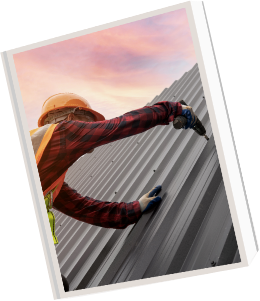How Long Does A Roof Last in Illinois? Real Life Expectancy & Factors
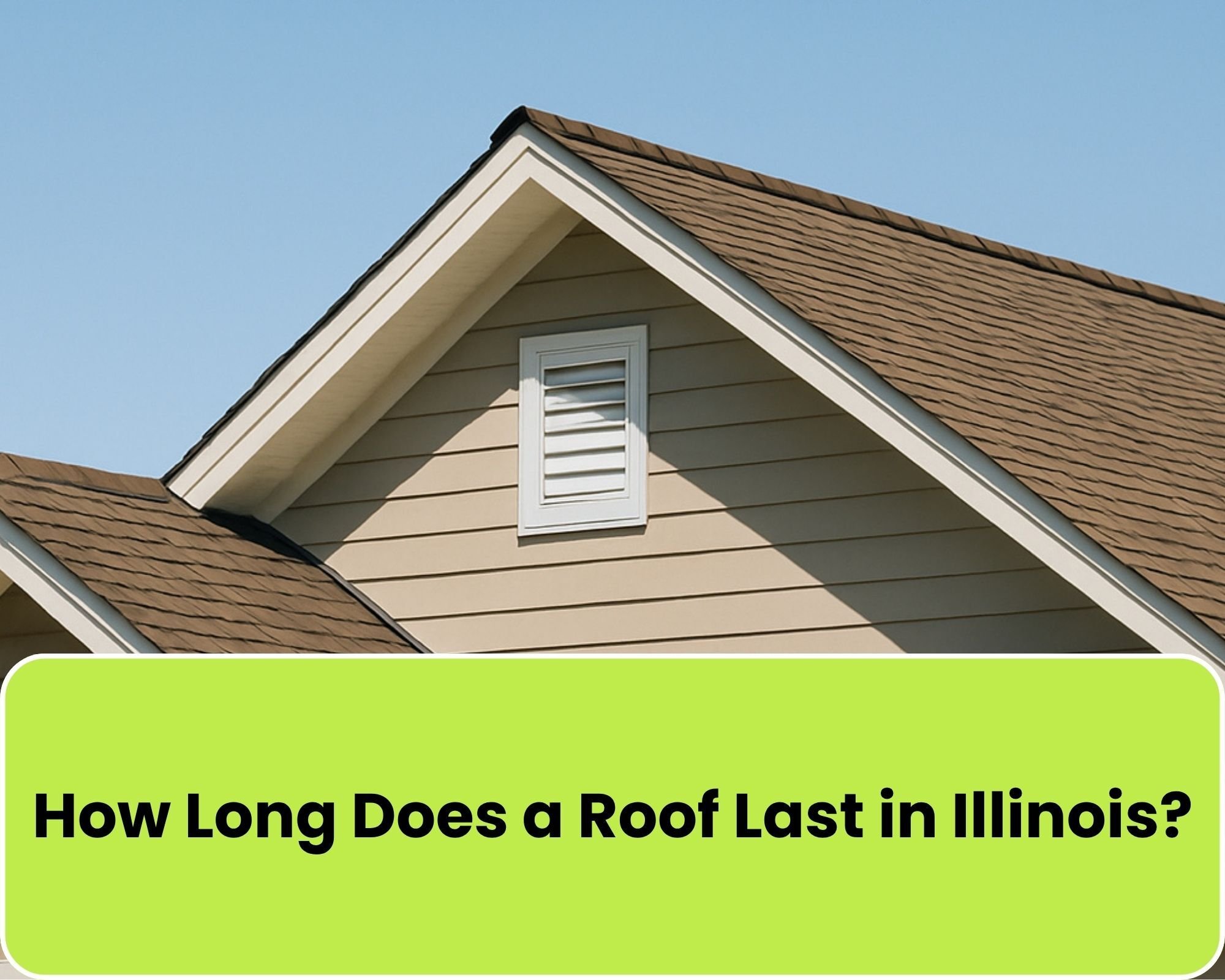
When homeowners think about roof replacement, a really common question that comes up is: “How long will a new roof last?”
Unfortunately, the answer isn’t as straightforward as many contractors might make it seem. Roof lifespans are influenced by a mix of materials, workmanship, and climate conditions. Without clear information, it’s difficult to make sense of it all. But that doesn’t mean we’re not going to answer the question in this article.
At Happy Roofing, we’ve inspected and replaced hundreds of roofs across the greater Naperville area. Over the years, our team has seen firsthand how local weather patterns, installation issues, and poor maintenance can affect the longevity of a roof. Knowing what to expect can help you take steps to protect and maintain the health of your roof.
In this article, we'll explore what impacts the lifespan of a roof in Illinois. You'll learn:
- The average life expectancy of common roofing materials like asphalt shingles.
- The climate, from hail and high winds to dramatic temperature swings.
- How installation quality and maintenance play an even bigger role than most people realize.
- Actionable steps you can take to prolong the life of your roof and protect your investment.
By the end, you'll understand the key factors that shape a roof's lifespan and how to keep yours performing at its best.
Table of Contents
- What Is a Roof's Life Expectancy in Illinois
- What Affects Roof Longevity?
- What Are the Signs of an Aging Roof?
- What to Do If You're Concerned About the Age of Your Roof
How Long Should a Roof Last in Illinois?
The average asphalt shingle roof lasts between 15 and 30 years, depending on installation quality, proper ventilation, and what materials were used.
Asphalt shingles are by far the most common type of roof we see in Illinois, but they're not the only option. Here's how long you can expect other roof materials to last, compared to asphalt shingles:
| Material Type | Average Lifespan | Maintenance Level | Key Takeaway |
|---|---|---|---|
| Asphalt Shingles | 15–30 years | Low to Moderate | The most common and affordable option, with many styles available, may need occasional cleaning |
| Metal Roofing | 40–70 years | Low | High upfront cost, but excellent long-term durability and weather resistance with minimal upkeep. |
| Cedar Shake | 20–35 years | High | Beautiful and natural, but requires regular cleaning and treatment to prevent moisture and moss damage. |
| Synthetic (EuroShield, etc.) | 30–50 years | Low | Durable, sustainable, and impact-resistant; great for extreme climates but at a higher material cost. |
What Key Factors Affect Roof Longevity in Illinois?
Local weather patterns, installation quality, and ongoing maintenance all play major roles in how long your roof protects your home. Even with high-quality materials, a roof's true lifespan depends on more than just what's on the surface. Here's what matters most in Illinois:
Roof Material Type
Not all roofing materials age the same way, and the type you choose can have one of the biggest impacts on how long your roof lasts. Each material reacts differently to Illinois' climate and storms. Some materials require more upkeep, while others trade a higher upfront cost for long-term durability.
We mentioned these materials in the section above, but we'll go into more detail here:
- Asphalt shingles (15-30 years): These are popular because they're relatively affordable, versatile, and hold up well against the mix of heat, cold, and seasonal storms that are prevalent in Illinois. That said, their actual lifespan depends heavily on installation quality, attic ventilation, and exposure to the elements. A well-installed, well-ventilated asphalt roof can easily make it past 20 years, but poor ventilation or repeated storm damage can shorten that dramatically. They typically don't require much maintenance, but in heavily shaded areas, occasional soft washing may be needed to keep algae or moss growth under control.
- Metal (40–70 years): Metal roofs are less common in suburban neighborhoods, but are known for their longevity. They can easily last several decades with minimal maintenance, though they come with a higher upfront cost. In Illinois, they perform especially well on homes that need durability against hail, snow, and strong winds.
- Cedar shake (20–35 years): Cedar shake roofs (made from natural wood) offer a natural, high-end look but require much more maintenance than asphalt or metal. The humid summers and icy winters in Illinois can cause the wood to expand, contract, and eventually split over time. Regular treatment and cleaning are key to getting the upper end of that lifespan.
- Synthetic Roofing (30–50 years): Synthetic materials like EuroShield are designed to replicate the look of wood or slate while offering increased durability and sustainability. They perform exceptionally well against hailstorms and temperature swings that frequent Illinois, but are less common due to their higher material cost.
Quality of Installation
Even with the best materials, our opinion is that the quality of installation is the single most important factor in how long a roof will last. In our experience serving homeowners across the Naperville area, most premature roof failures come from installation errors rather than storms or product defects.
Here are areas where some roof installations may fall short:
- Flashing: Flashing is the thin metal waterproofing that seals and directs water away from joints and openings (like chimneys, skylights, and roof valleys) so moisture can't seep beneath the shingles. When it's bent, rusted, reused, or poorly sealed, water can get under shingles and cause leaks or rot the decking below. Not every contractor replaces flashing during roof replacements, and if you don't see this on your quote, it's a good idea to ask if it's included.
- Nailing: Improper nailing is a leading cause of premature roof failure. Nails driven at the wrong angle, wrong location, or at the wrong depth can tear shingles or back out over time. This can lead to nail pops (where the nail head works its way up through the shingle), leaks, and a lack of wind resistance.
- Ventilation Assessment: A well-ventilated attic allows hot, moist air to escape, preventing heat buildup and condensation that damage both shingles and decking. Without a good balance of intake and exhaust ventilation, trapped moisture accelerates wear and can even void manufacturer warranties. Your contractor should assess your roof's ventilation before providing you with a quote.
The video below shows a roof that we inspected and found to have poor ventilation, and it illustrates what nail pops look like:
Weather Conditions
Illinois' climate puts roofs through a wide range of weather conditions. From freezing winters to humid summers and sudden storms, these environmental factors can wear down even high-quality materials faster than expected.
Here are common, local weather occurrences that impact the life of roofs in Illinois:
- Freeze-thaw cycles: When temperatures swing above and below freezing, moisture inside or beneath shingles expands and contracts. Over time, that movement loosens granules (the coating on asphalt shingles, meant to provide protection and color), cracks shingles, and can lead to leaks. Rubberized or more flexible materials like Malarkey's asphalt shingles or synthetic options like EuroShield, handle this stress better than brittle, lower-grade asphalt.
- Snow and ice damming: Snow buildup along roof edges can melt unevenly when attic heat escapes, refreezing into ice dams. These dams trap water behind them, forcing it under shingles and into decking. Proper attic ventilation and insulation are the best defenses against this type of winter damage.
- Wind damage: Strong windstorms are common across Illinois, especially in spring and late fall. High winds can lift shingles, break their adhesive seals, or even tear them off completely. Over time, repeated exposure weakens the roof's surface and shortens its lifespan. If you live in a wind-prone area, metal roofing or shingles with higher wind ratings can reduce the amount of repairs needed over time.
- Hail damage: Even small hailstones can bruise or crack shingles, knock off protective granules, and weaken the waterproof barrier underneath. The damage isn't always obvious right away, but over time, those weakened spots can lead to leaks and premature aging. Choosing impact-resistant shingles or synthetic materials like EuroShield can greatly reduce the risk of hail-related repairs and extend your roof's lifespan.
Below is a photo of a shingle that was impacted by hail. You can see the area where the granules (the coating that protects and provides shingles with their color) are missing:
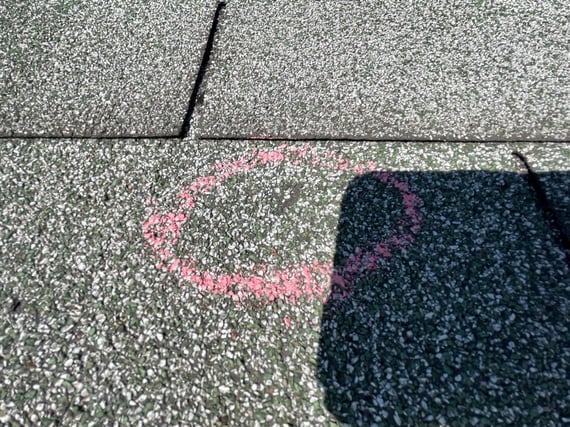
Attic Ventilation and Insulation
You may not think your attic has anything to do with your roof's longevity, but it's one of the most important factors. Like we mentioned earlier, proper airflow in your attic protects your shingles from the inside out and helps prevent some of the most common (and costly) roof issues Illinois homeowners face.
Insulation also plays an important role, keeping your attic temperatures consistent and reducing the risk of moisture buildup.
Here's how your attic influences your roof's health:
- Temperature Regulation: Proper insulation keeps your attic from overheating in the summer and prevents excessive heat loss in the winter. Working together with ventilation, this balance reduces stress on shingles. A well-insulated attic can also reduce how hard your HVAC system has to work.
- Moisture Control: Good ventilation allows humid air to escape instead of condensing on wood and insulation. Without it, trapped moisture can lead to mold growth, wood rot, and premature deterioration of the roof decking.
Some contractors don't make the necessary upgrades to ventilation systems that have poor airflow, potentially shortening the life of your new roof. Ask your contractor if they assessed your roof's ventilation before they give you their quote. By controlling both temperature and humidity, you're giving your roof a better chance at a long service life.
Tree Coverage and Debris
The trees that make your property beautiful can also quietly shorten your roof's lifespan. Over time, shade, debris, and moisture create the perfect conditions for hidden damage, especially if your roof isn't cleaned or inspected regularly.
- Overhanging Branches: Branches that hang too close to the roof can scrape against shingles, wearing away protective granules and exposing the material underneath. They also drop leaves, seeds, and twigs that collect in gutters or valleys, trapping moisture and preventing proper drainage. Trimming back branches a few feet from the roof helps reduce both impact and debris buildup.
- Organic Growth: Shady areas of the roof often stay damp longer, which encourages moss, algae, and lichen to grow. Moss holds moisture directly against shingles, breaking down the surface and lifting edges over time if left unchecked. Algae growth is mostly cosmetic, leaving dark staining across the shingles. Gentle, professional soft washing can help keep growth under control.
We've included an example of a roof with excessive lichen growth below:
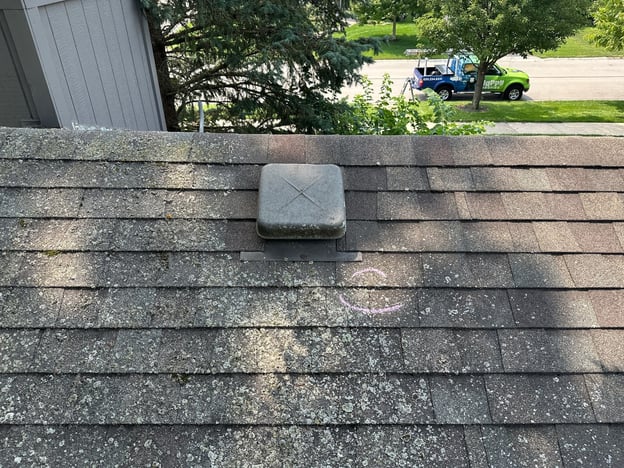
Regular Maintenance and Repairs
Even the most durable roof needs consistent care. Regular maintenance is one of the easiest ways to prevent small issues from turning into expensive problems.
Here are some simple steps you can take to help your Illinois roof last longer and stay in great shape:
- Soft Washing: A gentle, low-pressure cleaning (known as soft washing) removes dirt, algae, moss, and bird droppings without damaging the shingles. It's especially important for cedar shake roofs, which can trap organic debris, and for asphalt shingles in shaded or damp areas where moss and algae tend to grow. Routine soft washing not only improves appearance but also helps preserve the protective surface of your roof.
- Replacing Damaged Shingles Quickly: A single missing or cracked shingle may not seem like much, but it can expose the underlayment to water and wind damage. Replacing problem areas early prevents leaks, wood rot, and structural decay. Regular visual inspections, especially after major storms, can save thousands in long-term repairs.
- Cleaning Gutters: Clogged gutters cause water to back up, causing it to overflow and pool around the foundation, or leak inside the home. Clearing them out at least twice a year (especially after heavy leaf fall or spring storms) helps water drain properly and prevents damage to both the roof and the structure below. Gutter guards are a great way to prevent debris from building up quickly.
Here is an example of a gutter guard installed:
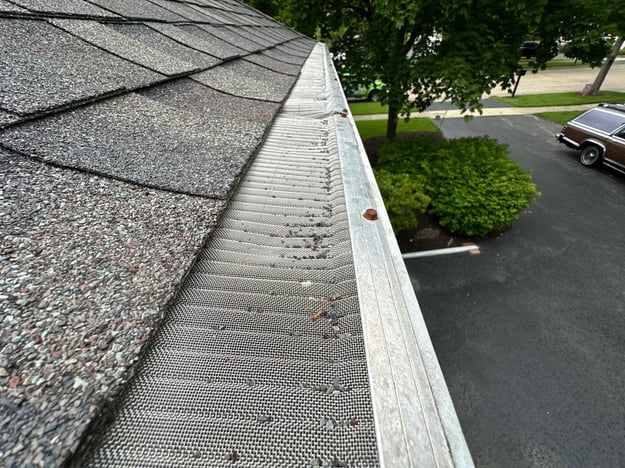
What Are the Signs of an Aging Roof?
Frequent leaks appearing in your home, missing shingles, and a warped roofline can all indicate that your roof is nearing the end of its service life.
Over time, exposure to sun, wind, and moisture begins to break down materials. Spotting these warning signs early can help you plan repairs or replacement before major damage occurs.
- Curling or missing shingles: As shingles age, the protective oils in the asphalt dry out, causing the material to curl or become brittle. You might also notice missing shingles after high winds or storms. Both are signs that your roof is losing its ability to shed water effectively.
- Warped or uneven roof surface: If your roofline looks wavy or uneven from the ground, it's often a sign of warped roof decking beneath the surface. Decking (the foundational layer found under the shingles, often made of plywood) can warp from prolonged moisture exposure or poor ventilation. Once this happens, shingles no longer sit flat, leaving gaps where water can pool or seep in. Warping can also indicate structural issues, which can be a safety concern.
- Water stains or leaks: Water spots on ceilings, damp attic insulation, or visible leaks are late-stage symptoms of roof wear. Even small leaks can cause mold, rot, and structural damage if they're not fixed. If you notice discoloration or moisture, it's best to have the roof inspected promptly before structural repairs become necessary.
- Granules in gutters: The gritty material you may see in gutters or downspouts often comes from asphalt shingles. Granules protect shingles from UV rays and impact damage, so their loss is a strong indicator of aging. When you start seeing a significant amount of granules in gutters or downspouts, especially after storms, it means your shingles are nearing the end of their service life.
- Energy bills increasing: Aging roofs can start losing their ability to effectively insulate the home. Damaged shingles, poor ventilation, or thinning insulation allow heat to escape in winter and build up in summer. If your energy bills are climbing without another clear cause, it might be that your roof is losing its efficiency.
Below, you can see how shingles with excessive granule loss start to look patchy as the asphalt underneath is exposed:
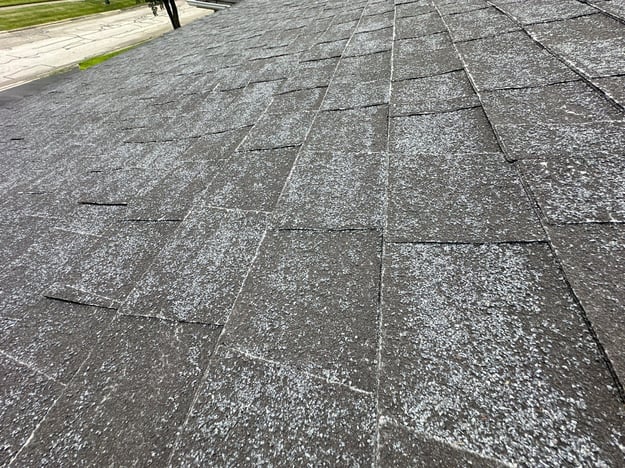
What to Do if You're Concerned About Your Roof's Age
Your roof is one of the most important systems protecting your home. Understanding what affects its lifespan and what signs to look out for can help you stay ahead of any possible issues.
Knowing when to schedule an inspection can make all the difference. If you've noticed signs of wear, leaks, or simply aren't sure how your roof is holding up, you don't need to wait for the next storm to find out. Read our next article, When Should You Schedule a Roof Inspection: 8 Warning Signs Your Roof Needs Professional Attention, to learn exactly what to look for and when it's time to call in a professional.
If you'd rather have someone look at your roof right away, you can schedule a roof inspection with us for a clear picture of your roof's health. We'll go over your options with you and answer any questions you may have, without any obligation to move forward with us.
The Author: Pedro Toledano
Happy Roofing is a trusted roofing company dedicated to providing top-quality roofing services to residential and commercial clients. With years of experience, they specialize in roof installations, repairs, and maintenance, ensuring durability and customer satisfaction. The team is known for their professional approach, timely service, and attention to detail. Happy Roofing prides itself on using high-quality materials and offering competitive pricing. Follow their Facebook page for updates on projects, customer testimonials, and tips on maintaining your roof in excellent condition.


.jpg?width=300&name=Media%20Template%20(1).jpg)


